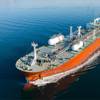Spending HMT Will End Dredging Crisis
Using the Harbor Maintenance Trust Fund for its intended purpose will end the dredging crisis on the Great Lakes declared a stone shipper at a briefing for the Great Lakes delegation in Washington, DC on April 2 hosted by Great Lakes Maritime Task Force. “We need approximately $200m to clear the dredging backlog on the Great Lakes,” said Thomas Buck, President and Chief Executive Officer of Carmeuse Lime & Stone. “The fund collects $1.1b annually, but only spends $700m. That leaves a surplus of nearly $5b. It’s time to put the ‘trust’ back in the Trust Fund.”
Carmeuse Lime & Stone operates three large stone quarries that ship via the Great Lakes. In 2008, those quarries loaded 14 million tons of aggregate and fluxstone into Great Lakes freighters. Buck used a sampling of vessel loadings to illustrate the negative impacts of the dredging crisis on Carmeuse. “In June, a vessel with a designed carrying capacity of 28,300 net tons left our plant in Calcite, Michigan, with only a little more than 24,000 tons in her holds. The dredging crisis cost us nearly 15 percent of the vessel’s carrying capacity.”
Another vessel left Carmeuse’s Cedarville, Michigan, quarry with more than 4,400 tons of carrying capacity unused. The reason vessels cannot carry full loads is decades of inadequate funding for dredging. The U.S. Army Corps of Engineers estimates it needs $200m to restore the Great Lakes navigation system to functional dimensions.
The Harbor Maintenance Trust Fund is the depository for a Federal tax levied on shipping. It has been in effect since 1987. Buck projected the dredging crisis costs Carmeuse almost two million tons of cargo each year. “The same number of vessels needed to deliver Carmeuse’s annual tonnage could deliver another 1.9 million tons of limestone and another 50,000 tons of kiln fuel if Great Lakes ports and waterways were properly dredged.”
Buck dismissed the higher water levels expected on the Great Lakes this year as any kind of solution to the dredging crisis. “The higher water levels will mitigate only a small percentage of the problem. The increases in water levels will be measured in inches, whereas vessels are losing feet of draft.”
Buck stressed the efficiencies of Great Lakes shipping are even more important today given the struggling economy. “The U.S. Army Corps of Engineers recently determined that Great Lakes shipping annually saves its customers $3.6b in transportation costs versus land-based modes. The potential savings would be much greater if the Lakes were dredged to functional dimensions.”
“Great Lakes shipping is also the most environmentally-friendly mode of transportation,” said Buck. “Ships use less fuel and produce lower emissions than trains and trucks. That’s important to Carmeuse, and in line with our efforts to find cleaner ways to run the business. We are currently using bio-diesel in much of our mobile equipment, and have modified some of our lime kilns to accommodate bio-fuels.”
Carmeuse is a major economic force in the region. It has almost 2,500 employees in North America, with 800 at Lakes operations. Payroll taxes alone top $13m a year. Buck closed by re-emphasizing there is a solution to the dredging crisis. “Congress must use the Harbor Maintenance Trust for its intended purpose – fund dredging on the Lakes and other U.S. waterways.”












